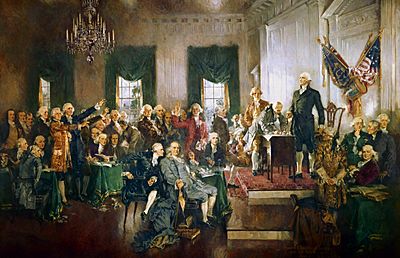Constitutional convention (political meeting) facts for kids
A constitutional convention is a convention where an organization's constitution can be created, revised, or amended. A general constitutional convention is called to create the first constitution of a political unit or to entirely replace an existing constitution. An unlimited constitutional convention is called to revise an existing constitution. A limited constitutional convention is restricted to revising only a limited area of the current constitution. However, such conventions may decide to go beyond their original authority. For example, the United States Constitutional Convention of 1787 was supposed to be limited to amending the Articles of Confederation. Instead, they wrote an entirely new constitution.
United States
Constitutional convention
The United States Constitution is silent regarding rules of how a constitutional convention would operate. There are no standards for states calling for a convention. Even calls for a constitutional convention made 50 to 100 years ago on an entirely different topic might be counted towards the required 34 states needed to call a constitutional convention. Oklahoma, for example, called for a convention in 1976 but then rescinded it in 2009. They were concerned that such a convention might make unforeseen changes in any area of the Constitution. Those in favor of a constitutional convention may want to count Oklahoma's call for a convention anyway.
Article V
Article Five of the United States Constitution provides two ways that constitutional amendments can be proposed:
- By 2/3 of both houses of the Congress.
- By a majority vote in 2/3 of the state legislatures.
Either way that amendments are proposed, they must then be ratified. Article Five gives two choices for how an amendment can be ratified. Congress chooses which way to use.
- Letting the state legislatures ratify the amendment. If three-fourths (75%) of the state legislatures ratify the amendment, it becomes part of the Constitution.
- The second option is for Congress to ask each state to create a "ratifying convention." This is a group of people – not members of the state legislature—who would decide whether or not to ratify the amendment. If ratifying conventions in three-fourths of the states ratify the amendment, it becomes part of the Constitution.
Congress has only used the second option once: after it proposed the 21st Amendment. (This amendment cancelled the 18th Amendment, which made alcohol illegal in the United States. The 21st Amendment made alcohol legal again.) At the time, Congress thought that this would be the more democratic option.
Organizing
An organized body (when an organization already has a constitution, officers and by-laws) will usually have appointed a committee on credentials and a committee on program before the convention begins. The committee on credentials (also called registration) checks the identity of delegates and gives each one a name badge or card as evidence they belong there. A program committee should have copies of the program available to all delegates before the convention begins. Other committees may be appointed as necessary.
Images for kids
-
The Virginia Constitutional Convention, 1830 (George Catlin, ca. 1830). Many state constituent assemblies, like the 1830 Virginia Constitutional Convention, were highly formalized but the legitimacy of the constitution they drafted depended on whether it was authorized by the people, not whether a particular procedure was followed.
See also
 In Spanish: Asamblea constituyente para niños
In Spanish: Asamblea constituyente para niños




